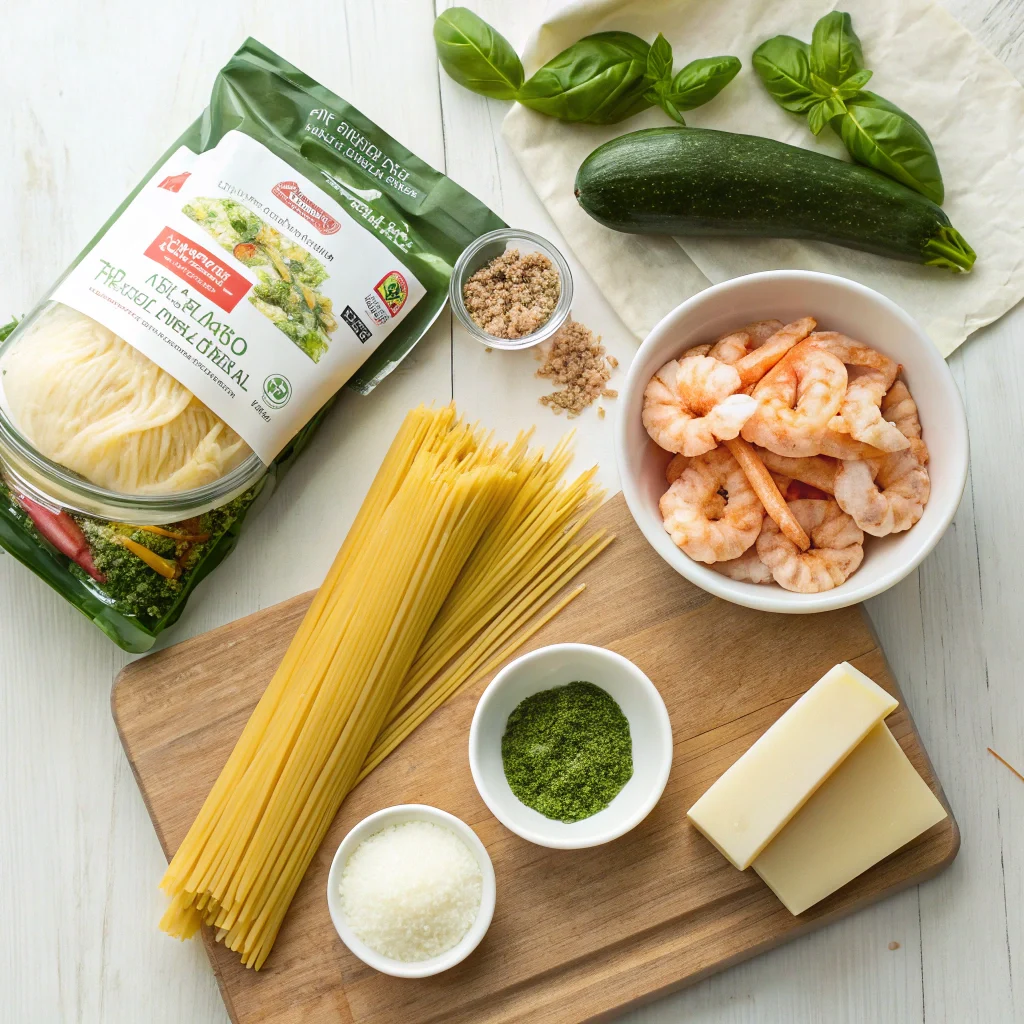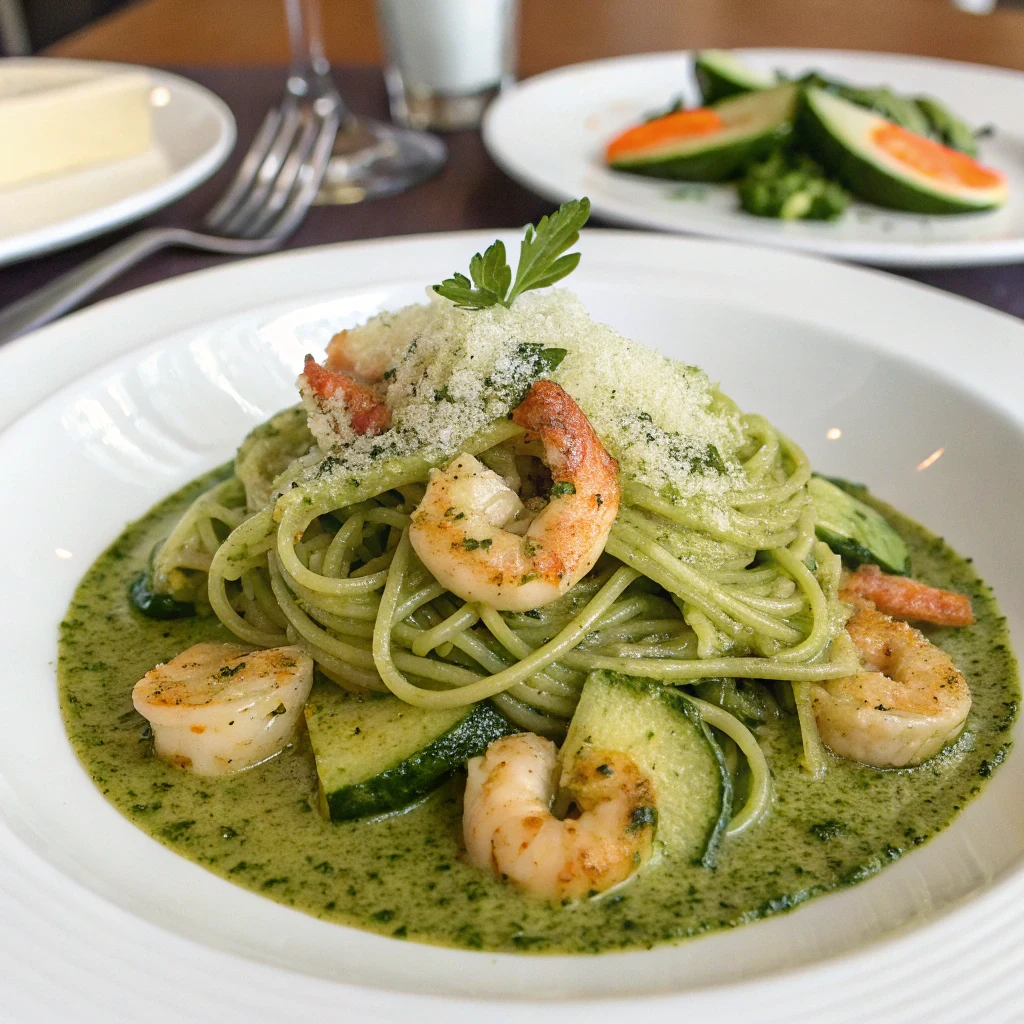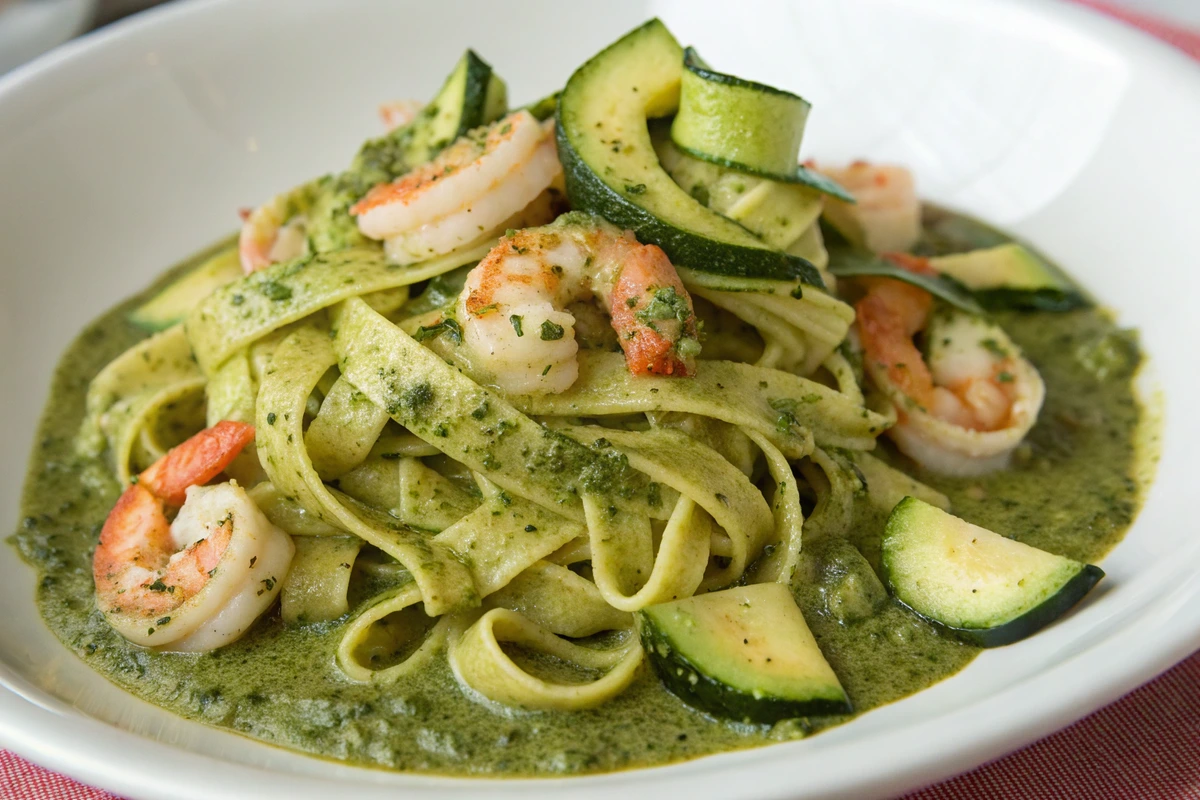This article is your ultimate guide to crafting mouthwatering pesto langostino zucchini and pasta recipes. From understanding the unique ingredients that make these dishes stand out to mastering the step-by-step preparation, you’ll learn how to whip up a restaurant-quality meal right in your kitchen. We’ll also share tips, serving suggestions, and exciting variations to help you elevate this classic recipe. Let’s dive in!
Introduction to Pesto Langostino Zucchini and Pasta
What Makes Pesto Langostino Zucchini Pasta Unique?
Pesto langostino zucchini pasta isn’t just another pasta dish—it’s a delightful medley of flavors and textures that hits all the right notes. The herbaceous pesto, creamy pasta, and tender zucchini create a vibrant base, while the addition of sweet langostinos adds an indulgent twist. Langostinos, often called “mini lobsters,” deliver a rich, seafood flavor without the hefty price tag. Together, these ingredients strike a perfect balance between freshness and decadence.
What sets this dish apart is its versatility. You can tweak it to match your preferences—go low-carb with zucchini noodles, or make it hearty with fettuccine or penne. Plus, with its minimal cooking time, it’s perfect for weeknight dinners or even as a show-stopping centerpiece for a dinner party.
Health Benefits of Key Ingredients
Beyond its incredible flavor, this dish is packed with nutrients. Zucchini, for example, is rich in vitamins A and C, which are great for your immune system. It’s also low in calories and high in fiber, making it an excellent choice for a healthy diet.
Langostinos are another powerhouse ingredient. They’re loaded with protein, omega-3 fatty acids, and essential vitamins like B12. Combined with basil pesto, which contains healthy fats from olive oil and pine nuts, this dish offers both taste and nutrition in one satisfying plate.
Stay tuned for the next part, where we’ll dive into the essential ingredients for crafting the perfect pesto langostino zucchini pasta!
Essential Ingredients for Pesto Langostino Zucchini and Pasta
Langostino: The Star of the Dish
The real hero of any pesto langostino zucchini and pasta recipes is undoubtedly the langostino. These delicate, lobster-like crustaceans bring a sweet, buttery flavor that perfectly complements the freshness of pesto and zucchini. Whether fresh or frozen, langostinos are easy to prepare and quick to cook, making them an excellent choice for fast yet gourmet meals.
When buying langostino, aim for quality over quantity. Opt for sustainably sourced options, if possible. Fresh langostinos have a firm texture and a slightly briny aroma. However, frozen ones work just as well, provided you defrost them correctly before cooking.
Zucchini and Pasta: A Perfect Pairing
Zucchini isn’t just a filler ingredient—it’s a game-changer. Its mild, slightly nutty taste and tender texture make it a natural partner for pesto and pasta. You can slice it into ribbons, dice it, or spiralize it into zoodles for a lighter, low-carb option.
As for the pasta, the possibilities are endless! Long strands like linguine or spaghetti allow the pesto to coat evenly, while shapes like penne or orecchiette hold little pools of sauce in every bite. Whole wheat or gluten-free pasta can also be used for a healthier twist. No matter your choice, always cook your pasta al dente for the best texture.
Pesto Variations: From Traditional to Creative
Classic basil pesto is always a winner, but why not shake things up? For pesto langostino zucchini and pasta recipes, you can experiment with variations like arugula pesto, sun-dried tomato pesto, or even avocado pesto. These swaps not only add unique flavors but also provide more ways to enjoy this versatile dish.
Step-by-Step Pesto Langostino Zucchini and Pasta Recipes
How to Make Classic Pesto Langostino Zucchini Pasta
Ingredients:
- 1 lb pasta (linguine, penne, or your choice)
- 1 lb cooked langostino tails
- 2 medium zucchinis, diced or spiralized
- 1 cup basil pesto (store-bought or homemade)
- 2 tbsp olive oil
- Salt and pepper to taste
- Parmesan cheese, for garnish
Instructions:
- Cook the Pasta: Boil your pasta in salted water until al dente. Reserve ½ cup of pasta water, then drain.
- Prepare the Zucchini: In a large skillet, heat olive oil over medium heat. Add the zucchini and sauté until slightly softened, about 5 minutes.
- Combine Ingredients: Toss the cooked langostino with the zucchini, then stir in the pesto. Add pasta and reserved pasta water, mixing until everything is evenly coated.
- Serve and Garnish: Transfer to a serving bowl and top with Parmesan cheese. Serve warm.
Low-Carb Pesto Langostino Zucchini Noodles Recipe
For a lighter take on pesto langostino zucchini and pasta recipes, swap the pasta for zucchini noodles. Simply spiralize 3-4 zucchinis and sauté them briefly until tender. Combine with langostino and pesto, just like in the classic recipe.
Creamy Pesto Langostino Pasta with Zucchini
If you’re craving extra indulgence, this creamy version is a must-try.
Ingredients:

- 1 lb pasta
- 1 lb langostino
- 2 medium zucchinis
- ¾ cup basil pesto
- ½ cup heavy cream
- 2 tbsp butter
- ¼ cup grated Parmesan
Instructions:
- Cook pasta as usual.
- In a skillet, melt butter and sauté zucchini. Stir in pesto and heavy cream, letting it simmer for a few minutes.
- Add the langostino, pasta, and Parmesan, tossing everything together until creamy and well-coated. Serve hot!

With these recipes, you’re all set to enjoy a variety of pesto langostino zucchini and pasta recipes. Next, we’ll dive into tips and tricks for perfect results. Stay tuned!
Tips and Tricks for Perfect Results
Choosing Fresh Ingredients for Pesto Langostino Recipes
When preparing pesto langostino zucchini and pasta recipes, the quality of your ingredients makes all the difference. Always opt for fresh basil if making homemade pesto—it’s the key to that vibrant, herbaceous flavor. Similarly, use high-quality olive oil and freshly grated Parmesan for a rich, authentic taste.
For the zucchini, choose medium-sized ones that are firm to the touch. Avoid overly large zucchini, as they tend to have more seeds and less flavor. When it comes to langostinos, fresh is ideal, but frozen can work wonderfully when properly defrosted. Lastly, don’t skimp on the pasta; brands with a high semolina content yield a better texture.
Preventing Overcooking in Pesto Langostino Pasta Recipes
Langostinos cook incredibly fast, so timing is crucial. Overcooking can make them rubbery, which nobody wants. Add them to your dish just before serving, allowing the residual heat from the sauce or pasta to warm them through. This ensures they remain tender and flavorful.
Homemade Pesto vs. Store-Bought for Langostino Recipes
While store-bought pesto is convenient, making your own takes the dish to the next level. A simple blend of basil, garlic, olive oil, pine nuts, and Parmesan can be whipped up in minutes. However, if you’re short on time, select a high-quality store-bought option. For more ideas on enhancing your recipes, check out this guide to perfect sauces and marinades.
Serving Suggestions and Pairings
Plating Ideas for a Stunning Presentation
Presentation matters, especially with home-cooked meals! To start, for pesto langostino zucchini and pasta recipes, a clean white plate allows the vibrant green of the pesto and the golden hue of the langostino to pop. Furthermore, garnishing with freshly grated Parmesan and a few basil leaves adds a professional touch. If you’re using zucchini noodles, you can also twist them into neat piles to achieve a restaurant-worthy look.
Wine Pairings for Pesto Pasta
Pairing wine with pesto can elevate the dining experience. A crisp Sauvignon Blanc or a light Pinot Grigio complements the herbal notes of the basil and the sweetness of the langostino beautifully. For red wine lovers, opt for a lighter red like a Barbera or Pinot Noir, which won’t overpower the delicate seafood flavors.
For more delicious seafood pasta ideas, explore this guide to shrimp scampi recipes. Stay tuned for the next section, where we’ll dive into exciting variations and customizations for this versatile dish
Variations and Customizations
Vegetarian Options: Swapping Langostino with Alternatives
Not a seafood fan or catering to vegetarians? Don’t worry—pesto langostino zucchini and pasta recipes can easily be modified! Replace langostino with roasted cherry tomatoes or sautéed mushrooms for a plant-based twist. These options still provide a savory, satisfying flavor that pairs beautifully with pesto and zucchini.
You can also toss in some grilled artichoke hearts or lightly toasted pine nuts for added texture. These small swaps keep the dish vibrant and hearty while ensuring everyone at the table can enjoy it.
Adding a Spicy Kick
For those who crave a bit of heat, adding spice is an easy way to elevate your pesto langostino zucchini and pasta recipes. To begin with, you can sprinkle in some red pepper flakes or, alternatively, add a pinch of cayenne to the pesto. Moreover, sautéing a finely chopped chili with the zucchini provides an extra fiery touch. Ultimately, the heat enhances the flavors without overpowering the dish’s fresh and creamy elements.
Incorporating Seasonal Ingredients
One of the best things about this recipe is its adaptability to seasonal ingredients. In the summer, fresh corn kernels or diced yellow squash can enhance the zucchini’s sweetness. During colder months, try adding roasted butternut squash or a handful of wilted spinach for a cozy, nutrient-rich version. Seasonal ingredients not only add variety but also allow you to experiment with textures and flavors.
Calorie Breakdown for Zucchini Pesto Pasta Recipes
Zucchini pesto pasta comes in various delicious forms, each with its own calorie profile depending on the ingredients and preparation style. Here’s a quick breakdown of the calorie count per serving for the three featured recipes from the article, helping you choose the best option for your dietary needs.
| Recipe | Calories per Serving (4 servings) | Description |
|---|---|---|
| Classic Pesto Langostino Zucchini Pasta | 537.5 | A traditional recipe with pasta, langostino, zucchini, and pesto. |
| Low-Carb Pesto Langostino Zucchini Noodles | 350 | A lighter, low-carb version using zucchini noodles instead of pasta. |
| Creamy Pesto Langostino Pasta with Zucchini | 579 | A richer version with heavy cream added to the classic recipe. |
This table provides a quick reference for understanding the approximate calorie content of these mouthwatering recipes!
Frequently Asked Questions
Why add pasta water to pesto?
Adding pasta water to pesto is a game-changer for achieving the perfect sauce consistency. The starchy water helps emulsify the pesto, making it smoother and creamier as it coats the pasta. Additionally, it binds the sauce to the noodles, ensuring every bite is flavorful. Without it, the pesto might feel too thick or unevenly distributed, so this simple step makes all the difference!
Can you put pesto straight into pasta?
Yes, you can put pesto straight into pasta, but there are a few tips to keep in mind. First, mix the pesto with a bit of reserved pasta water to create a smoother sauce. Then, toss it with the hot, freshly cooked pasta to ensure even coating. Finally, adjust the seasoning and add toppings like Parmesan for extra flavor.
How to use pesto other than pasta?
Pesto is versatile and can be used in many dishes beyond pasta. First, spread it on sandwiches or wraps for a burst of flavor. Next, use it as a topping for grilled chicken or fish. Then, mix it into soups or salads for a fresh twist. Finally, drizzle it over roasted vegetables to elevate their taste!
Do you warm up pesto before you put it over spaghetti?
No, you don’t need to warm up pesto before putting it over spaghetti. The heat from the freshly cooked pasta is enough to gently warm the pesto. First, cook and drain the pasta, saving a bit of pasta water. Then, toss the pesto with the hot pasta, adding some pasta water to create a smooth sauce. This preserves the pesto’s fresh flavor!

